African Pygmy Hedge hog care sheet.
coming again soon. Due to my last care sheet being copied and used on other sites, with out prior permission, I am forced to re-write it and add a copy right to it. Please contact me for any info that you require.
Kindest regards Dean.......
Kindest regards Dean.......
African Pygmy Hedgehog Care sheet
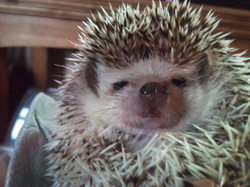
Hedgehogs are not rodents, and are insectivores in the family Erinaceidae. African Pygmy Hedgehogs are a hybrid created around twenty years ago for the American pet Market, by breeding the White-bellied or Four-toed Hedgehog (Atelerix albiventris) and the Algerian Hedgehog (Atelerix algirus)
They never existed as a species in the wild. They are considerably smaller than a wild European hedgehog, do not have fleas and would not be able to tolerate living outside.
They never existed as a species in the wild. They are considerably smaller than a wild European hedgehog, do not have fleas and would not be able to tolerate living outside.
Enclosures.
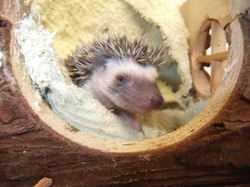
African Pygmy Hedgehogs live around 3-6 years and do require daily interaction to keep them accustomed to you.
They require an enclosure of at the very least 3ft x 1.5ft x 1.5ft but the larger the better, My enclosures are 3’ x 2’ x 18” and to utilize the space I have fitted a shelf with a ramp for access.
A solid-based large wheel (very important, they can travel up to 10 miles in one night!) I use the flying saucer type.
A soft bed (plastic hides are ideal with terry towling or fleece as the bed) and other items.
It is also equally important that you keep them warm, so if you have a chilly/cold home you may need to add a “Thermostatically controlled Heat mat” to keep the temperature up so they do not go in to a state of toper/hibernation/Bromation. They do not need to hibernate, unlike our European hedgehogs.
They require an enclosure of at the very least 3ft x 1.5ft x 1.5ft but the larger the better, My enclosures are 3’ x 2’ x 18” and to utilize the space I have fitted a shelf with a ramp for access.
A solid-based large wheel (very important, they can travel up to 10 miles in one night!) I use the flying saucer type.
A soft bed (plastic hides are ideal with terry towling or fleece as the bed) and other items.
It is also equally important that you keep them warm, so if you have a chilly/cold home you may need to add a “Thermostatically controlled Heat mat” to keep the temperature up so they do not go in to a state of toper/hibernation/Bromation. They do not need to hibernate, unlike our European hedgehogs.
Handling.
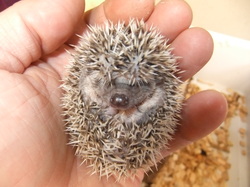
Picking up your hedgehog can be difficult at first, especially if your hedgehog (or yourself!) is not used to it. African Pygmy Hedgehogs may ball up if unhappy or startled and can raise spines also when upset. An unhappy hedgehog may make huffing/clicking sounds and could even ball up. I have a female that does this every time I handle her, but after a few minutes or so she soon stops being grumpy and carries on her own business.
Although some African Pygmy Hedgehogs may be content to be sat there are also hedgehogs that will be interested in exploring. They can also like to forage, with some keepers hiding mealworms and other treats in a deep tray full of substrate for digging.
You will need to handle your African Pygmy Hedgehog every day to keep them accustomed to you and well socialised.
Although some African Pygmy Hedgehogs may be content to be sat there are also hedgehogs that will be interested in exploring. They can also like to forage, with some keepers hiding mealworms and other treats in a deep tray full of substrate for digging.
You will need to handle your African Pygmy Hedgehog every day to keep them accustomed to you and well socialised.
Quilling
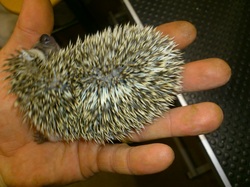
At the age of 4 weeks an African Pygmy Hedgehog has its first quilling - this is where it will lose its quills and replace them with new ones. Other quillings occur at 6, 9 and 12 weeks. The 9 week quilling is where adult colouration comes in and it is from this point that a proper colour identification can be made. The adult quilling may last around 2-6 weeks.
Whilst quilling, an African Pygmy Hedgehog may become quite grumpy, huffy or even aggressive. It is important to still socialise your hedgehog during this time, although you may need to take extra care as the quilling process can be quite painful for your hog.
During quilling it can help to give your hedgehog a luke-warm bath with a moisturising oatmeal shampoo. This helps soften the skin, allowing the new quills to break through the skin easier.
Whilst quilling, an African Pygmy Hedgehog may become quite grumpy, huffy or even aggressive. It is important to still socialise your hedgehog during this time, although you may need to take extra care as the quilling process can be quite painful for your hog.
During quilling it can help to give your hedgehog a luke-warm bath with a moisturising oatmeal shampoo. This helps soften the skin, allowing the new quills to break through the skin easier.
Annointing
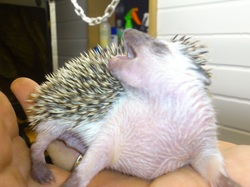
If an African Pygmy Hedgehog comes across a new taste or pungent smell it may trigger an odd behaviour known as annointing. This is where they froth at the mouth and then lick this frothy saliva all across their back. Although there is not yet a clear explanation for why they do this, it is a natural behaviour and nothing to be worried about.
Diet.
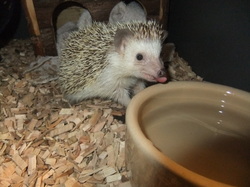
African Pygmy Hedgehogs are lactose intolerant and so should not be given dairy products. They should also not be given avocado, chocolate, citrus fruits, garlic, fish, grape or grape products, onion, or nuts and seeds. If it doubt, please check with a reputable vet or ask good breeders or keepers such as those found on good African Pygmy Hedgehog forums.
A varied diet is important although some African Pygmy Hedgehogs can be picky eaters.
A healthy African Pygmy Hedgehog should weigh between 300-500g with males typically being smaller. It is a good idea to keep a record of your Hedgehogs weight so you can notice any problems, although it is worth bearing in mind that a recent toilet can mean a difference of around 10g.
A varied diet is important although some African Pygmy Hedgehogs can be picky eaters.
A healthy African Pygmy Hedgehog should weigh between 300-500g with males typically being smaller. It is a good idea to keep a record of your Hedgehogs weight so you can notice any problems, although it is worth bearing in mind that a recent toilet can mean a difference of around 10g.
Water
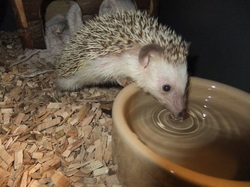
Fresh water should be available constantly, tap water is fine offered in a shallow dish or bottle, but I prefer to offer bottled water.
Cat foods

These need to be non-fish based, dry cat food biscuits. It should have a minimum of 30% protein and no more than 10% fat. This should be constantly available. I use Hills Science plan “Chicken for adults”
Food marketed at European hedgehogs is not suitable for African Pygmy Hedgehogs.
Food marketed at European hedgehogs is not suitable for African Pygmy Hedgehogs.
Insects

African Pygmy Hedgehogs are insectivorous and so should be offered items such as mealworms, crickets, locusts and cockroaches. These are available live which provides the most environmental enrichment but can also be purchased dried or canned.
Cooked and fresh

Your African Pygmy Hedgehogs diet can be supplemented with cooked foods such chicken, beef or lamb mince, boiled rice, or scrambled egg (without milk). They may also appreciate fresh vegetables such as broccoli, carrots, cauliflower, mashed potato, peas, sweetcorn, mashed swede. Some fruits are also suitable such as apple, apricot, banana, mango, melon, and strawberries.
Although I generally just keep to the live insects and “Hills Science plan”
Although I generally just keep to the live insects and “Hills Science plan”
Daily Care.

African Pygmy Hedgehogs can be quite messy and if you do not keep up with daily cleaning (Poo picking) they can quickly become very smelly. I have a nightly regime of Poo Picking and washing equipment so I hardly notice any smell at all. Some Hogs can be litter trained, if you can manage this it will make life much easier for you.
Copy right, I do not mind if people wish to use this information given, however do not take the piss and copy, word, for word.
If you wish to use it then please ask and reference back to the original piece.
If you wish to use it then please ask and reference back to the original piece.